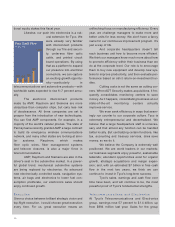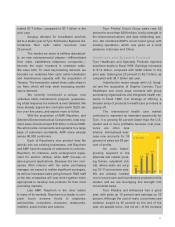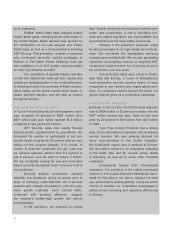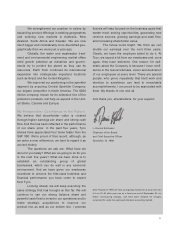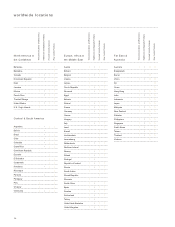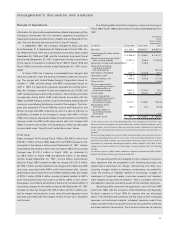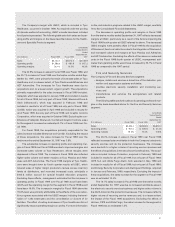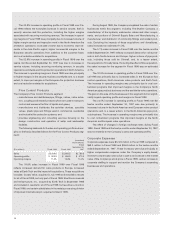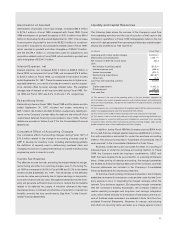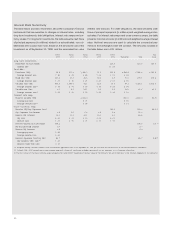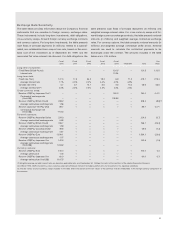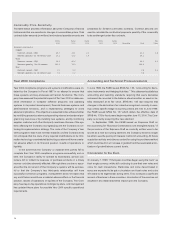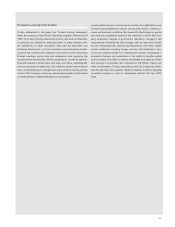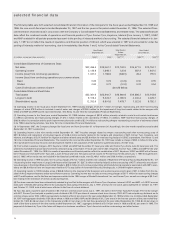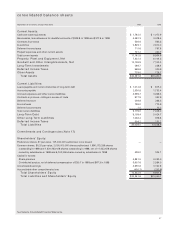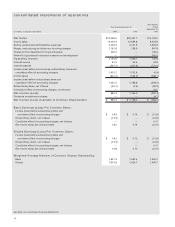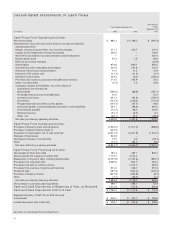ADT 1999 Annual Report Download - page 32
Download and view the complete annual report
Please find page 32 of the 1999 ADT annual report below. You can navigate through the pages in the report by either clicking on the pages listed below, or by using the keyword search tool below to find specific information within the annual report.
30
earnings at the time the reserves are established. Amounts expended
for merger, restructuring and other non-recurring costs are charged
against the reserves as they are paid out. If the amount of the reserves
proves to be greater than the costs actually incurred, any excess is
credited against merger, restructuring and other non-recurring
charges in the Consolidated Statement of Operations in the period in
which that determination is made.
In Fiscal 1999, the Company established merger, restructuring
and other non-recurring reserves of $434.9 million in connection with
its merger with USSC and $841.8 million in connection with its merger
with AMP. At the beginning of the fiscal year, there existed merger,
restructuring and other non-recurring reserves of $303.7 million
related to pooling of interests transactions consummated in prior
years and other restructuring charges taken by the merged companies
prior to their combination with the Company. During Fiscal 1999, the
Company paid out $633.6 million in cash and incurred $478.5 million
in non-cash charges that were charged against these reserves. Also
in Fiscal 1999, the Company determined that $15.0 million of merger,
restructuring and other non-recurring reserves established in prior
years was not needed and deducted that amount from the merger,
restructuring and other non-recurring charges for Fiscal 1999. At Sep-
tember 30, 1999, there remained $453.3 million of merger, restructur-
ing and other non-recurring reserves on the Company’s Consolidated
Balance Sheet, of which $366.3 million is included in current liabilities
and $87.0 million is included in long-term liabilities. The Company
expects to pay out approximately $350.0 million in cash in Fiscal 2000
for merger, restructuring and other non-recurring expenses that will be
charged against these reserves.
All other business combination transactions completed in Fiscal
1999 were required to be accounted for under the purchase account-
ing method. At the time each purchase acquisition is made, the Com-
pany establishes a reserve for transaction costs and the costs of
integrating each purchased company within the relevant Tyco busi-
ness segment. The amounts of such reserves established in Fiscal
1999 are detailed in Note 3 to the Consolidated Financial Statements.
These amounts are not charged against current earnings but are
treated as additional purchase price consideration and have the effect
of increasing the amount of goodwill recorded in connection with the
respective acquisition. Indeed, management views these costs as the
equivalent of additional purchase price consideration when it consid-
ers making an acquisition. If the amount of the reserves proves to be
in excess of costs actually incurred, any excess goes to reduce the
goodwill account that was established at the time the acquisition was
made.
In Fiscal 1999, the Company made acquisitions that were
accounted for under the purchase accounting method at an aggregate
cost of $6,923.3 million. Of this amount, $4,546.8 million was paid in
cash (net of cash acquired), $1,449.6 million was paid in the form of
Tyco common shares, and the Company assumed $926.9 million in
debt. In connection with these acquisitions, the Company established
purchase accounting reserves of $525.4 million for transaction and
integration costs. At the beginning of Fiscal 1999, purchase account-
ing reserves were $505.6 million as a result of purchase accounting
transactions made in prior years. During Fiscal 1999, the Company
paid out $354.4 million in cash and incurred $16.3 million in non-cash
charges against the reserves established during and prior to Fiscal
1999. Also in Fiscal 1999, the Company determined that $90.0 million
of purchase accounting reserves related to acquisitions prior to Fiscal
1999 were not needed and reversed that amount against goodwill. At
September 30, 1999, there remained $570.3 million in purchase
accounting reserves on the Company’s Consolidated Balance Sheet,
of which $408.0 million is included in current liabilities and $162.3 mil-
lion is included in long-term liabilities. The Company expects to pay
out approximately $350.0 million in cash in Fiscal 2000 that will be
charged against these purchase accounting reserves.
The following details the Fiscal 1999 capital expenditures and
depreciation by segment:
Capital
(in millions) Expenditures Depreciation
Telecommunications and Electronics $ 488.5 $446.2
Healthcare and Specialty Products 235.9(1) 179.3
Fire and Security Services 746.3 262.2
Flow Control Products 135.1 87.0
Corporate 26.7 4.9
Total $1,632.5 $979.6
(1) Excludes $234.0 million related to the purchase of leased property in connection with
the merger with USSC.
The Company continues to fund capital expenditures to improve
the cost structure of its businesses, to invest in new processes and
technology, and to maintain high quality production standards. The
level of capital expenditures for the Fire and Security Services seg-
ment significantly exceeded, and is expected to continue to signifi-
cantly exceed, depreciation due to the large volume growth of new
residential subscriber systems capitalized. The level of capital expen-
ditures in the other segments is expected to increase moderately in
Fiscal 2000. The source of funds for capital expenditures is expected
to be cash from operating activities.
The provision for income taxes in the Consolidated Statement of
Operations for Fiscal 1999 was $620.2 million, but the amount of
income taxes paid (net of refunds) during the year was only $209.7 mil-
lion. After adjustment for deferred income taxes of acquired compa-
nies and other items, the net increase in deferred income taxes was
$334.3 million. The increase in deferred income taxes is attributable
primarily to current utilization of deductions on restructuring, other
non-recurring charges and purchase accounting spending, other tim-
ing differences between book and tax recognition of income and
expense, utilization of net operating loss and credit carryforwards, and
the tax benefits of stock option exercises.
The net change in working capital, net of the effects of acquisi-
tions and divestitures, was an increase of $85.5 million. These
changes are set forth in detail in the Consolidated Statement of Cash
Flows. The increase in working capital accounts is attributable to the
higher level of business activity in Fiscal 1999 as reflected in the
increased sales over the prior year. Management focuses on maxi-
mizing the cash flow from its operating businesses and attempts to
keep the working capital employed in the businesses to the minimum
level required for efficient operations.
In addition, the Company used $234.0 million of cash to purchase
the USSC North Haven facilities and $637.8 million to purchase its
own common shares. The Company repurchases its own shares from


